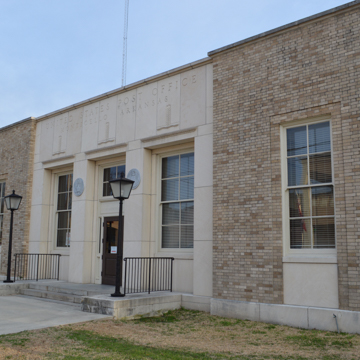The plain severity of this small one-story buff brick, flat-roofed building is a familiar design for post offices in small towns in the state that were funded by the WPA. Here the central entrance has a cast-concrete surround with a deeply recessed entrance and tall flanking windows. On display in the lobby is a wall-mounted three-piece terra-cotta relief sculpture, Tomato Culture, by New York sculptor Berta Margoulies, a Polish American who studied art in Paris and at the Art Students’ League in New York. The central, largest piece (51 × 28 inches in height) depicts a farm worker with mules preparing to plow; the two smaller flanking pieces portray a man and a woman harvesting tomatoes. The figures are bold, simplified and stylized. At the time the subject matter was chosen, Monticello advertised itself as the “Tomato Capital of Arkansas.”
You are here
Old U.S. Post Office
1936, Louis A. Simon, Supervising Architect of the U.S. Treasury; 1962 addition. 221 W. Gaines St.
If SAH Archipedia has been useful to you, please consider supporting it.
SAH Archipedia tells the story of the United States through its buildings, landscapes, and cities. This freely available resource empowers the public with authoritative knowledge that deepens their understanding and appreciation of the built environment. But the Society of Architectural Historians, which created SAH Archipedia with University of Virginia Press, needs your support to maintain the high-caliber research, writing, photography, cartography, editing, design, and programming that make SAH Archipedia a trusted online resource available to all who value the history of place, heritage tourism, and learning.


